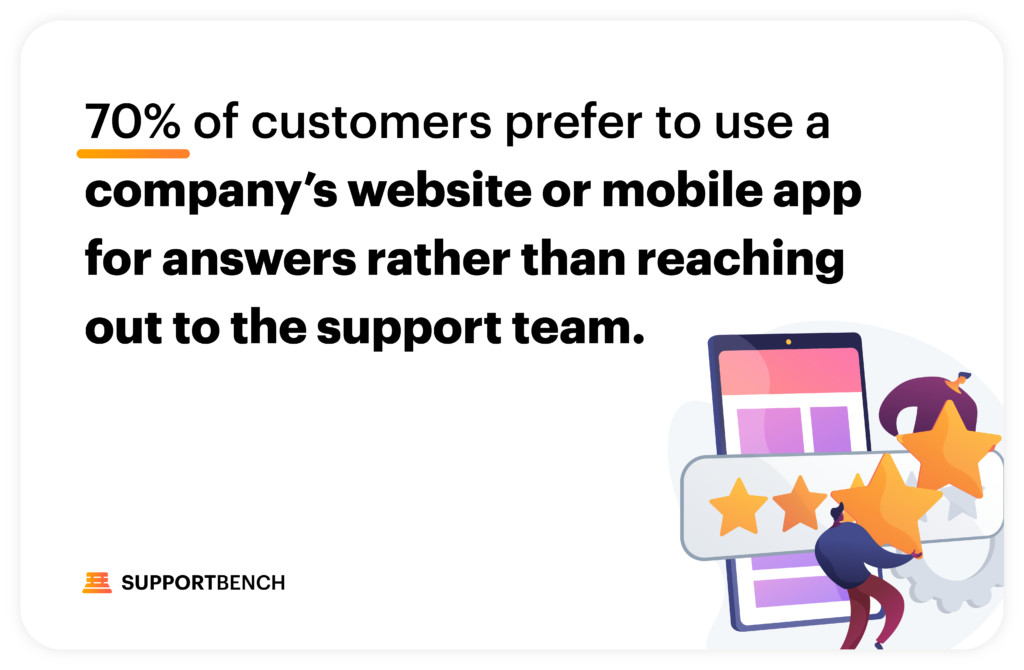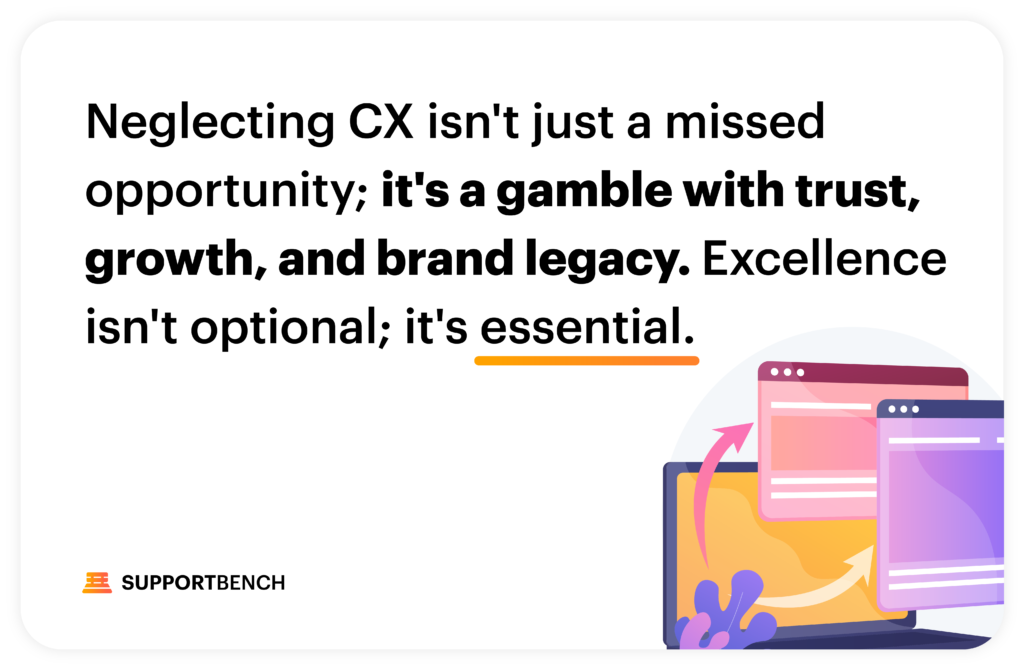The modern customer experience (CX) landscape is ever-evolving, driven by technological advancements and changing consumer behavior. Many businesses, however, fail to recognize when their CX strategy becomes outdated or ineffective. Here are seven indicators that your CX approach may need a makeover.

1. Rising Customer Churn Rates
When customers begin leaving in greater numbers, it signals that something in your CX strategy is lacking. According to a report by Customer Experience Magazine, 67% of consumers cite bad experiences as a reason for churn. It’s so important to regularly survey your customers, not only when they leave, but also at various touchpoints during their journey. You must also ensure these surveys include not just NPS but also Custom Surveys and CES, which delve deeper into specific interaction experiences. For example, by leveraging platforms like Supportbench, businesses can understand their customer’s health score, gaining insights into their experiences and potentially averting the churn before it begins.
2. Low Customer Engagement with Knowledge Base
A recent study by Forrester revealed that 70% of customers prefer to use a company’s website or mobile app for answers rather than reaching out to the support team. You need to implement or revamp a KCS (Knowledge-Centered Service) knowledge base as an efficient KCS allows customers to help themselves, reducing strain on support teams. Specifically, for companies that notice low engagement with their knowledge base, introducing AI-driven summaries and easy-to-navigate articles, akin to what Supportbench offers, can significantly enhance user experience.
3. Inconsistent Customer Support Experiences
Consistency is a cornerstone of great customer experience. McKinsey & Company states that consistency across the customer journey can lift revenue by 15% while also increasing customer satisfaction rates. It makes sense to adopt Dynamic SLAs to ensure consistent experiences; meaning tailoring SLAs based on what’s happening within a case. So, if a product renewal is approaching, tighter SLAs can be applied to guarantee a prompt and superior service experience.
4. Limited Data-Driven Decision Making
In the words of Bernard Marr, a strategic performance consultant, “Data is the oil of the digital era.” If your CX strategy isn’t data-driven, you’re likely missing out on crucial insights. It’s vital to leverage AI technologies for sentiment analysis, intent detection, and emotional scoring. And most certainly platforms like Supportbench with integrated AI features can provide these insights, leading to actionable recommendations. In this way, data analytics are more than just numbers, they become narratives that tell a brand where they excel and where they need to pivot.
5. Dependence on IT for Customer Support Systems
In a digitally transformed era, customer support should be agile. Waiting on IT to make system changes can be a bottleneck. However, adopting a platform that reduces the dependency on IT, thereby ensures customer support systems can be modified in real-time by the support team themselves. Companies like Supportbench offer autonomy, allowing for immediate action, and introducing elements like chatbots or customizing customer portals without the IT hassle.
6. Lack of Real-Time Customer Feedback Mechanisms
Bill Gates once said, “We all need people who will give us feedback. That’s how we improve.” In the realm of CX, this couldn’t be truer. And introducing real-time feedback mechanisms, such as website widgets that allow users to browse knowledge bases, raise tickets, or engage with AI bots. ChatGPT-driven bots, like the ones integrated within Supportbench, can engage users in real-time, answering FAQs and redirecting complex queries to human agents.
7. Inefficient Customer Support Infrastructure Scaling
Growth is the goal for most businesses. However, if your customer support strategy doesn’t scale efficiently with your growth, it can lead to bottlenecks and degraded customer experiences. Implementing solutions that offer scalability, accommodating more significant customer numbers, more support agents, and increasing data points can help dramatically. With a 360-degree customer overview, platforms in the vein of Supportbench can offer scalable insights, ensuring that as the business grows, so does its understanding of its customers.
Tying It All Together
The customer experience paradigm is shifting, driven by technology and new customer behaviors. Companies must be vigilant, agile, and ready to adapt. While not every solution fits all, platforms that emphasize seamless customer support management, data-driven optimization, and scalable infrastructures can pave the way for enterprises that want to stay ahead of the curve. It’s essential to acknowledge the innovative approaches platforms like Supportbench are bringing to the table, emphasizing value and helping customer support teams shine as the heroes in the modern B2B Enterprise world.
Not all companies see the value of a CX strategy revamp

Ignoring the evident cracks in your customer experience strategy can have grave consequences. As the saying goes, “A stitch in time saves nine,” and it’s crucial for businesses, especially in the B2B Enterprise sphere, to comprehend the long-term ramifications of inertia in this domain.
Diminishing Customer Trust and Brand Loyalty
One of the most significant assets for any company is the trust and loyalty of its customer base. An outdated or inefficient CX strategy can lead to repeated negative experiences, causing a rapid erosion of this trust. The aftermath? A reduced customer lifetime value and the daunting task of winning back disenfranchised customers. For enterprises, especially those with high-value, long-term contracts, this can equate to massive revenue losses.
Increased Customer Acquisition Costs (CAC)
When churn rates rise due to poor CX, companies naturally turn towards acquiring new customers. However, according to a study by Harvard Business Review, acquiring a new customer can be anywhere from 5 to 25 times more expensive than retaining an existing one. This spike in CAC without a corresponding increase in customer value can quickly turn profit margins negative.
Operational Inefficiencies and Increased Overheads
A subpar CX strategy isn’t just detrimental externally; it affects internal operations too. Teams end up firefighting issues rather than focusing on proactive support and innovation. This reactive stance means more man-hours, more resources, and ultimately, bloated operational costs with diminishing returns.
Reduced Competitive Advantage
In a market where businesses are vying for dominance, an effective CX strategy can be the differentiator. Neglecting it means giving competitors an edge. As competitors leverage advanced tools and methodologies, they offer superior experiences, leaving lagging companies in the dust and struggling to maintain market relevance.
Missed Opportunities for Growth and Innovation
An outdated CX strategy often lacks modern integrative tools that offer actionable insights. The consequence? Companies miss out on critical feedback loops that could inform product development, service enhancements, and innovation. While competitors capitalize on these insights for growth, companies with outdated strategies remain stagnant.
Employee Morale and Retention Issues
Continuous negative feedback and an overwhelmed support system can take a toll on your support teams’ morale. Facing disgruntled customers daily, without the tools or strategy to assist them effectively, can lead to increased employee turnover. The cost of hiring and training new staff, coupled with the loss of experienced personnel, can be a significant setback.
Risk of Negative Publicity
In our digital age, news travels fast. A few negative reviews or a viral post about a bad customer experience can tarnish a brand’s reputation that took years to build. The ripple effect of such negative publicity can deter potential clients, making recovery a slow and uphill battle.
The Road Forward
While the consequences of neglecting a necessary CX revamp are undeniably grim, the situation isn’t irreparable. By recognizing the signs early and leveraging the latest tools and methodologies, companies can course correct. Platforms like Supportbench, for instance, are not just about solving today’s problems but are geared towards anticipating tomorrow’s challenges, ensuring businesses stay agile, proactive, and ahead of the curve. And, for B2B enterprises, where contracts are significant, relationships long-term, and the stakes high, there’s no room for complacency. The future belongs to those who recognize the paramount importance of superior customer experience and take the requisite steps to ensure they deliver nothing short of excellence.











